The cellular phone is a magnificent invention that has become one of the most important gadgets in our lives. Although I started my travel career without one, I’m actually not sure how I did it! But it does open up a whole can of worms when it comes time to shop for the best international phone plans.
What happens when you have to travel internationally and need to use your phone? This is where is gets tricky – and if you don’t make the right choices, damn expensive. There are quite a few travelers that were shocked at their phone bills after coming back from their international trips due to a few phone calls or innocent texts.
The first (and only) time I experienced roaming charges, I was aghast. Like most people, I figured a couple of texts and a quick phone call whilst on a short trip to the U.S. from Canada wouldn’t be that expensive.
Wrong.
The extra $150 tacked on to my cell phone bill helped me understand that when I started traveling full-time, I’d need to rethink my cell phone travel strategy.
Well. I found a gazillion other ways to travel with your cell phone and remain connected to family and friends back home while abroad.
Here’s everything you need to know.
This article will provide you with a list of the best international phone plans, international data SIM cards, international roaming options, online phone numbers, and a lot of things that you should be aware of.
You’ll learn a ton of ways to use your cell phone while traveling. The best option for you depends on how long you’re traveling, where you’re going, what kind of phone and phone plan you currently have, and what your connectivity needs are.
I’ve included pros and cons for most options, along with who various options are recommended for.
I’ll also share my personal strategies (which have changed over time) so you too, can pay as little as $150 per year for your total cell phone usage. (Yes, you read that right).
Table of Contents:
Options for Locked Cell Phones
Options for Unlocked Cell Phones
How to Maintain a Local Phone Number in Your Home Country (or Abroad) Without Paying for a Full Plan
Best Strategies for Digital Nomads and Full-Time Travelers
Other Ways to Stay in Touch Abroad (With Locals and Family/Friends Back Home)
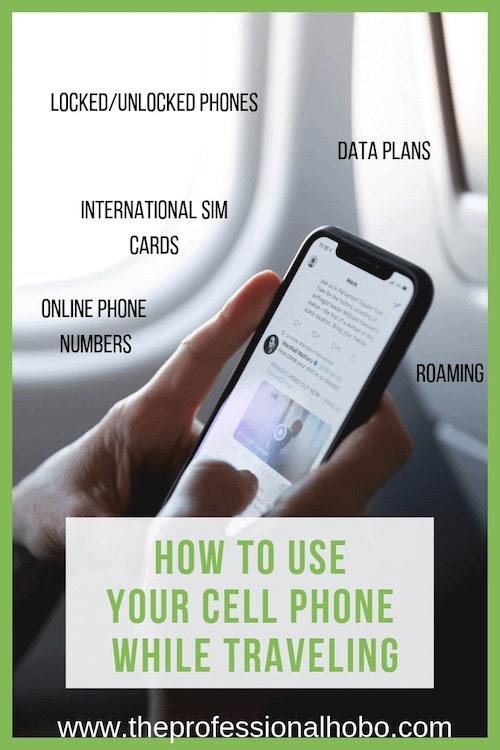
International Cell Phone Uses
First off, let’s examine how a cell phone (which these days, is almost always some sort of smartphone) can be used abroad.
As a traveler, there are multiple ways that you can use your phone internationally. Obviously you’ll want to be able to communicate with people back home. This can be done in a few different ways such as making international calls, sending international texts, or using international data. But that’s just the tip of the iceberg.
I’m really late to the “data” game. 2016 was the first year I ever had a plan that included data on my phone, and I’ll admit, it was a game-changer. To that point I’d simply bought pay-as-you-go SIM cards, and to keep my costs low, I only used my SIM card for calls; I relied on WiFi connections for everything else.
Well, the constant connectivity of having a data connection was not only a revelation, but I quickly learned to harness it to make travel safer and infinitely more convenient.

Other ways that you can use your phone internationally include using apps, checking your email, using GPS for maps and other things, or even posting on social media. These apps uses can be extremely helpful while you’re trying to navigate a new city or country.
Here are some of the most commonly used apps for travelers and how I use my (data-enabled) smartphone while traveling now:
(See also: The Best Must-Have Travel Apps)
Uber – Many of us are already familiar with this ride-sharing app that is available in many different countries. With Uber, you can request a ride with just a few taps on your phone rather than hailing a taxi on the street.
Say what you will about Uber and other sharing-economy initiatives; it is a gazillion times safer (and more cost-effective) than using taxis abroad – something especially important to stay safe as a solo female traveler. Uber drivers have public profiles, and before I get into their car I can see how many rides they’ve given and read reviews from other passengers. The rate is set in advance, so I can’t get scammed or taken the long way around, and I don’t need to worry about having the right amount of cash to pay them. (Read about how this traveler got scammed for 500,000 Vietnamese Dong in a taxi because she didn’t have change). But in order to effectively use Uber, you need a data connection.
Maps – Of course, you will definitely need a map app while you’re traveling to help you get around. Google Maps is probably the most popular and widely used map app in the world. I like Google Maps because of the great navigation/directions features (including public transportation), and ability to explore an area for restaurants and other establishments. It offers voice-guided turn-by-turn navigation in different languages, traffic conditions, public transportation options, and more. Other popular map apps that travelers use include Waze and Citymapper. Many map applications have offline versions in case you don’t have data, but they’re limited in usability.
Checking Flight Status and Airport Information – When you’re traveling, there’s always a possibility that your flight might be delayed or canceled. To avoid any stressful situations at the airport, it’s always a good idea to have a flight tracker app on your phone. Whether you’re checking flight times and gate/terminal information, figuring out how to get to the airport, or determining the best lounge to hang out in once you’re there, you need a connection. Some popular flight tracker apps include FlightAware and FlightStats. These apps will provide you with up-to-date information on your flight’s status as well as any delays or cancellations. You can also use these apps to check the airport’s information such as terminal maps, parking availability, and more.
Translation – If you’re traveling to a country where they speak a different language, then having a translation app on hand can be extremely helpful. Google Translate is one of the most popular translation apps and it offers text, voice, and even handwritten translations in over 100 languages. It also has features such as conversation mode, instant visual translation, and offline translation. While Google Translate has offline dictionaries available, some of the best features that support live conversations require a connection.
Finding Accommodation on the Fly – If you’re the type of traveler who likes to spontaneously book a last-minute trip, then having a hotel booking app on your phone can be a lifesaver. Twice in recent history I’ve found myself (for various reasons) sitting on my luggage and having to find last minute accommodation. In one case I was in Sri Lanka and used the free airport WiFi to find and book the place, but there was a snafu with the pickup, and once I left the inside of the airport (and the WiFi connection), I couldn’t go back in to touch base with the hotel. If I had a global data connection (read on for more about that), I wouldn’t have had that trouble.
Contacting/Staying in Touch With Locals – To use my strategy for renting apartments abroad – as I’ve done in places like Bali, Thailand, and Guatemala – you need to be able to connect with locals (with either a phone number or WhatsApp account; more on WhatsApp’s many uses later).
It’s also handy if you’re meeting up with somebody in a public spot and you’re running late or can’t find one another. I remember some stressful meet-ups with readers and colleagues in busy Tokyo train stations that didn’t go smoothly, mostly because I didn’t have any cell phone/data/WiFi connection.
Work on the Go – A digital nomad’s work is never done, and whether it’s sorting through emails or posting timely updates to social media, a connection on the go can increase productivity.
(See also: How to Go Location Independent – the Ultimate Beginner’s Guide)

Options for Locked Cell Phones – How to Use Your Phone Internationally Without Charges
If you got your phone from your cellular provider, then it’s probably locked. In most cases you are in a contract (often about two years), and the cost of the phone is incorporated into your monthly payments. Unfortunately this means you don’t have the best phone for international travel.
Locked phones are a pain, we know. You’re effectively leasing your phone from the carrier, and if you want to leave them, you have to pay a penalty. It also severely limits cost-effective options for using your phone internationally.
I recommend calling your provider to ask if your phone is locked, and if it is, ask them if you can unlock it. If they can’t (yet – they’re obligated to at some point), here are a few things you can do to get the most out of your locked phone while you’re abroad without racking up a huge bill.
Airplane Mode/Turn off Cellular Data
To avoid roaming charges, you need to turn off your home cell phone plan before you leave the country. You can do this by putting your phone on airplane mode (and turning the WiFi function back on so you can connect to local WiFi hotspots).
This will disable all data connections, so you won’t be able to use any apps that require an internet connection. However, your phone will still work if you’re connected to Wi-Fi.
Beware of borders! An American friend of mine was driving across the Canada/U.S. border. While he was still on the U.S. side, he sent a few instant messages. Unfortunately he was close enough to the border that unbeknownst to him, he was picking up Canadian cell signals, and his instant messages resulted in an extra $40 charged to his monthly bill.
Pros: It’s easy. Just put your phone on airplane mode and you’re ready to go. Alternately, go into your settings to manually turn off cellular data.
Cons: The problem with just using airplane mode and local WiFi hotspots is that it limits your usability abroad (eg: no Uber).
Recommended For: People taking short trips or organized tours where a data connection is largely unnecessary.
Get the Best International Roaming Plans You Can Find
If you prefer to use your phone while you’re abroad, then it’s important to find a good international roaming plan.
Many carriers offer international roaming plans, but they can be expensive. So, it’s worth shopping around and comparing different plans to find the one that best suits your needs.
Contact your carrier to see if there is an add-on or plan change you can make to include international roaming. This will enable you to make and receive calls to your home cell number while abroad, and usually to have a daily allocation of data usage.
Some providers offer great international plans for their customers, such as AT&T and Verizon plans:
- AT&T International Day Pass: Pay $10 per day for unlimited high-speed data, text and call in over 220 countries
- Verizon TravelPass: For as low as $5-$10 per day in over 185 countries you can have unlimited calls, texts and a regular daily data allowance.
- Verizon International Monthly Plan: If you’re a frequent international traveler, this could be the best option for you. For $100 per month, you get 250 minutes of talk and 1000 texts with 5 gigabytes of data in over 185 countries.
Most plans will offer you a discount if you’re traveling to multiple countries. For example, T-Mobile offers a $5 per day international roaming rate in over 210 countries for their customers.
Pros: You can continue to receive and make calls with your home phone number, and you don’t need to switch carriers or plans.
Cons: At $10/day (as an example), the cost for international roaming adds up quickly. Also, data speeds can be slow, so check the fine print with your carrier.
Recommended For: People who take regular short trips, and who need to be able to receive phone calls to their home number while abroad.
Temporarily Suspend Your Cell Phone Plan
Some carriers allow you to temporarily suspend your home phone plan so you don’t need to continue paying the full monthly fee for a plan you’re not using. This can be a great way to save money if you’re planning on being abroad for an extended period of time. Just be sure to check with your carrier before you leave to make sure that this is an option. There’s usually a charge for this, but it’s comparatively minimal (eg: $5-10/month).
Pros: You can travel for a few months without paying your home cell phone bill.
Cons: Your phone is limited solely to WiFi functions abroad.
Recommended For: People going on a long trip of fixed duration (eg: 2-6 months) and don’t want to lose their home phone number and plan.
Buy a Cheap Factory Unlocked International Cell Phone
If you’re planning on traveling overseas frequently, it might be worth your while to buy an international cell phone before you go. Factory unlocked phones can be used with any carrier, so you’ll be able to use a local SIM card without any issues.
International unlocked phones can be inexpensive, especially if you choose an older model or non-brand name. Then, you can use any of the unlocked phone options in the next section for full (cheap) connectivity abroad. Leave your regular cell phone at home.
Make sure the phone you buy is GSM unlocked. What does GSM unlocked mean? It stands for Global System for Mobile communications, and ensures that your phone can work with cell phone signals around the world.
Pros: Having an unlocked cell phone to travel with gives you way more cost-effective options. Also, if your cheap travel phone is lost or stolen, it’s not as expensive a loss.
Cons: Your travel phone will probably not have the same functionality and quality as your home phone. If it’s your only camera abroad, your travel photos/video may suffer. Also, you can’t receive phone calls to your home number.
Buy/Rent a Mobile WiFi Hotspot
With a locked phone and roaming turned off, you’ll be beholden to WiFi connections, unless you buy or rent a mobile WiFi hotspot.
Mobile WiFi Hotspots (like KeepGo and TravelWiFi, links below) are portable devices that harness global data to give all your devices (eg: cell phone, laptop) a WiFi internet connection, regardless of where you are.
With KeepGo, you buy your mobile hotspot ($99) and then pay for data on a pay-as-you-go basis – the more data you buy in one go, the less it costs. Or you can sign up for a pre-paid monthly plan that costs less on a per-GB basis but is only good in USA and Europe. You can switch between plans whenever you like.
With TravelWiFi, you can rent the hotspot ($7/day including unlimited data) or buy a hotspot for $149 and then buy data packages depending on where you’re going and for how long.
The best international wifi hotspot depends on your needs. To me, the KeepGo website is a bit easier to understand with global data, but if you’re only going on one short trip, renting a hotspot with Travel WiFi might make more sense.
Pros: You can connect multiple devices to one hotspot. It’s also great if you’re traveling with others, because you can share the connection (and cost).
Cons: It’s not cheap, and although the mobile hotspot is pocket-sized, it’s an extra thing you need to carry around with you.
Recommended For: This is a great option if you’re traveling as a couple or in a group, because you can connect multiple devices and share the cost.
Best Mobile WiFi Hotspot for International Travel
KeepGo (use coupon code PROFESSIONALHOBO for 10% off)
(Note, KeepGo is an affiliate link, which means if you make a purchase after clicking on it I will get a small referral fee. This doesn’t affect your price – and it helps me to keep this site running. Thank you!)
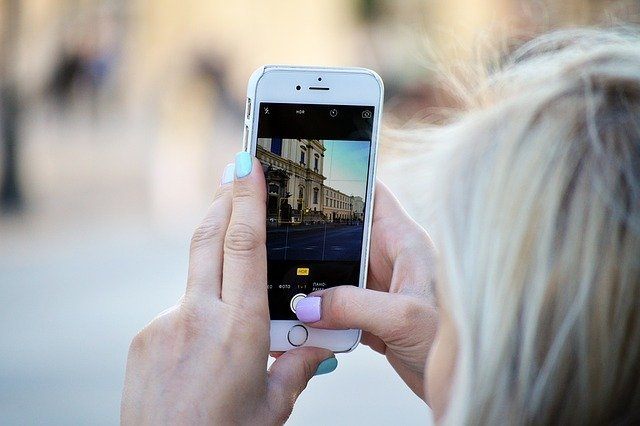
Options for Unlocked International Cell Phones
Despite the availability of options above, if you plan to travel long-term or full-time, the best travel phone is an unlocked phone, for a variety of reasons, including:
- It makes no sense to pay for a full-service plan in your home country if you’re not there to use it.
- Even if you pay for international roaming, your home phone number is useless to people at your destination who would have to dial long-distance to reach you even if you’re down the street from them.
- With an unlocked phone, you have the ability to insert other SIM cards, which includes various options listed below.
But, what exactly is an unlocked phone? An unlocked phone is a cell phone that is not tied to a specific carrier. That means you can use it with any carrier, both in the US and abroad.
There are a few different ways to get an unlocked phone. You can buy an unlocked phone outright, or you can buy a locked phone and then unlock it yourself.
If you’re buying a new phone, then you’ll want to make sure that it’s “factory unlocked” before you leave. That way, you can use it with any carrier, both in the US and abroad. However, if you’re not planning on buying a new phone, then you can still unlock your phone yourself. It’s a bit more complicated, but it can be done.
If you’re really attached to your home cell phone number, consider moving it to a super basic no-frills plan, or even to an online service, as will be discussed in a later section about how to maintain a local phone number in your home country (or abroad!) without paying for a full plan.
How to Unlock a Cell Phone
If you want to use your phone with a different carrier, then you’ll need to unlock it.
There are a few different ways to do this, but the most common is to use an unlocking code. Unlocking codes are simple and easy to use. Just enter the code into your phone and it will be unlocked. The only downside is that you’ll need to find an unlocking code for your specific phone. But, there are a few different ways to do this.
First, you can try searching online. There are a number of websites that offer unlocking codes for a variety of phones.
Regulations for unlocking cell phones are becoming more lenient, but on the whole, once your contract is finished with your carrier and/or your phone is paid off, you can unlock your phone.
Contact your carrier to do this for you; they won’t volunteer to unlock your phone, but they are legally obligated to after a certain amount of time has lapsed. It’s very easy; they can do it remotely, and in a day your phone will be magically unlocked.
And don’t worry: if you wish to continue with your regular monthly plan, unlocking it will not make a difference. It just gives you more options when you travel.
If you’re in the market for a new phone, do yourself a favour and just buy a factory unlocked phone. Sure, it costs a chunk of change, but whether you’re amortizing the cost of the phone over the life of a contract, or paying for it up front, trust me – you’re paying for it.
And having an unlocked phone opens up a world (literally!) of money-saving opportunities, which we’ll explore below.
Buying a Local SIM Card (and Where to Buy a SIM Card)
With an unlocked phone, you can change SIM cards as often as you change your socks if you’re so inclined. This is the best way to use your phone while you’re traveling because it’s much cheaper than using an international roaming plan. Plus, it’ll give you a local number that people can reach you at.
And it’s easy to do; in many countries you can buy a SIM card at the airport, and buy credit on a pay-as-you-go basis through an app or online. No plans, no contracts, no hassles. SIM cards are generally cheap, and in some cases, they’re effectively free with an equivalent amount of phone credit that comes with the card. Just be sure to buy a SIM card that is compatible with your phone.
Where to buy a SIM card? At the airport is best. Look for a stand in the baggage hall, or in the arrivals area just after you leave the baggage hall. They’ll even set it all up for you in minutes. That way, you can get online and start using your phone right away.
While I originally thought they’d cost more at the airport because of the convenience, they’re usually competitively priced. Also, once you leave the airport, buying a SIM card can be more complicated, as local shops aren’t always equipped to set up new plans for non-residents.
However, if you’re not able to do that, then you can also buy SIM cards at many convenience stores and mobile phone stores. Just be sure to ask for help if you’re not sure which one to get.
Pros: With a local SIM card, you get a local phone number and can make/receive calls at your destination for local rates. You may also have cellular data (depending on the plan you choose), which not only gives you great accessibility abroad, but if WiFi isn’t reliable (as is the case in many developing countries), you can make your phone a hotspot and tether your computer or tablet for internet access.
Cons: If you are only passing through, buying and installing a SIM card might be a hassle just to use it for a few days. (Note that some countries offer plans that are as short as a week, for this reason).
Recommended For: Travelers who are staying a few weeks at their destination and want to be accessible to locals. Also, travelers going to places where WiFi is unreliable and/or a data connection is needed.
To give you an idea of the cost, here is what I spent (in $USD) on local SIM cards in a handful of countries:
- Ecuador: $10 (pay-as-you-go talk/text credit included, data package add-ons are cheap; you can get unlimited plans for abut $20/month)
- Peru: Similar to Ecuador
- USA: $40 (included 30 days unlimited text/data, 100 minutes talk time)
- Indonesia: $10 (included 30 days unlimited talk/text and 4GB of data)
- India: $15 (included 60 days unlimited talk/text and 1GB of data per day)
- Thailand: $25 (included 30 days unlimited talk/text/data; renewal for another 30 days was $15)
- Vietnam: $10 (included 90 days unlimited talk/text/data)
- Australia: $40 (included 30 days unlimited talk/text, and 15GB of data)
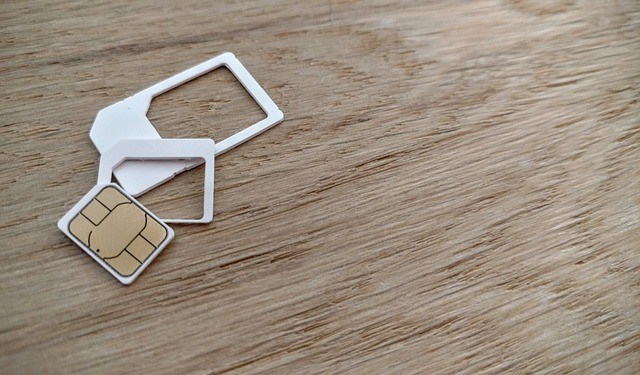
Buying an International SIM Card/Global SIM Card
If you’re going to be traveling to multiple countries, then it might be worth getting an international SIM card or a global SIM card.
How does an international SIM card work? An international SIM card (also known as a global SIM card) gives you connectivity in most countries with one SIM. It comes with a free phone number (usually based in the U.S. or UK) that your family and friends at home can call you on, and you can get foreign phone numbers (for example, maybe you want one at your destination) so you can make/receive calls with locals; foreign/extra phone numbers range from free to $20/month, depending on the SIM card and the country. If your home cell phone plan has forwarding services, you can forward those calls to your international SIM card number so you can continue to receive calls made to your home phone.
Pros: As a SIM card for international travel, you’ll save the hassle of getting a new local SIM card at each destination.
Cons: Not all global SIM cards are created equal, and you’ll need to spend a lot of time sifting through international SIM card reviews and fine print to find one that suits your needs. For example, one card gives you a free U.S. and UK number, but only gives you free incoming calls to the UK number. Depending on where you’re traveling, making a local call could cost a fortune (for example, $0.66/minute to make a local call in Peru). Other cards advertise free incoming calls, but the fine print reveals it’s not the case in all countries. Other cards yet charge connection fees (eg: $0.20) every time you make/receive a call. And many have complicated dialling procedures. While international SIM cards are cheaper than roaming, on the whole they’re not super cost-effective depending on your destination and needs. There are way cheaper methods of staying in touch with locals as well as distant family and friends (read on for more options).
Recommended For: Fast travel through many countries, where it doesn’t make sense to get a local SIM card or use one of the options below.
Best International SIM Card Providers
Now that you know all about international SIM cards, you might be wondering which one is the best. And, to be honest, there’s no easy answer.
I’ve tried a few global SIM cards over the years, and on the whole I haven’t found them particularly user-friendly nor worthwhile. But they’ve come a long way, and perhaps you’ll find one that’s perfect for you.
It really depends on where you’re going and how much you’re willing to spend. However, we’ve put together a list of some of the best international SIM card providers to help you make your decision. Note that most of these companies also offer data-only SIM cards and packages – which we’ll discuss below. However in most cases, these companies aren’t nearly as competitive as dedicated Data SIM cards are.
Go-SIM – Go-SIM offers international SIM cards that work in over 190 countries. They have a variety of different plans to choose from, so you can find one that fits your needs. Plus, they offer free shipping to anywhere in the world.
WorldSIM – WorldSIM’s international SIM cards work in over 200 countries, so you can easily stay connected no matter where you travel. With a variety of plans to choose from, you’re sure to find one that fits your needs and budget. Plus, WorldSIM offers free shipping worldwide!
One SimCard – One SimCard is a great option for international travelers. Their SIM cards work in over 210 countries and they offer a variety of different plans to choose from. So, whether you need a lot of data or just a little bit, you’re sure to find a plan that works for you.
BNEsim – The BNEsim international SIM card is a great option for those who need data while they’re traveling. With plans starting at just $9.99, you can get 1GB of data to use in over 70 countries.
Know Roaming – Know Roaming is widely known for their international SIM cards. Their cards work in over 190 countries and they offer a multitude of diverse plans to choose from.
Buying an International Data SIM Card or Data eSIM – For Local and International Data Plans
When I first learned about data SIM cards (now substantially being replaced with data eSIMs), I lumped them in the same category as international travel SIM cards and treated them skeptically. I have since changed my viewpoint (dramatically), and my current cell phone strategy involves using an international data SIM card all the time.
Data SIM cards can be offered in a few different formats, though these days they are usually offered as eSIMs. If you have an older phone that isn’t eSIM compatible, some data SIM providers can mail you a physical SIM.
A data SIM card offers you….you got it…..data. There’s no phone number associated with the SIM card, and in most cases you purchase data as you go through an app on your phone.
Data packages vary depending on the provider. Many offer packages based on geography; for example, if you’re going to Europe for two weeks, you can get a data plan that covers you in Europe for that time period. If your next trip is in South America, you can get a data plan specific to that area. Or you can purchase country-specific data packages, which are generally the cheapest. Or, you can purchase international data plans (global data plans) that tend to be more expensive but cover you anywhere/everywhere.
Prices for data also vary depending on the amount of data you purchase and the expiry date. The longer it is to the expiry date, the more the data will cost (but the longer you can amortize that expense).
My advice? Look for deals. I got into using Nomad eSIMs because they had a terrific promotion for Europe. Then I got into Airalo because they have the best global data rates not the market – hands down. Before that I used Flexiroam (which I no longer recommend).
I like the flexibility of global data, but you can get even better deals if you buy local/regional data.
Check out this article I wrote for an up-to-date list of international data eSIMs and how to use them.
My total global telecommunications costs are around $100….per year. (Read on to discover how I have a phone number without paying for a plan).
Pros: You have a data connection wherever you go, and you can customize your plan to each trip you take. With a data plan, you can also turn your phone into a hotspot to connect other devices if you’re in an area with poor/no WiFi. Having a constant data connection (when there’s no WiFi) has transformed my ease of travel.
Cons: Every data SIM provider has a different system and pricing structure, so if you want the best plan for you, you’ll have to do some comparison shopping.
Recommended For: Honestly? Everybody. I am all about using data SIM cards, when paired with some of the communication options listed later.
Best International Data SIM Cards
Airalo – Airalo is the data SIM card darling of many of my traveling colleagues, and I resisted at first but I finally get it – ha ha! It’s very user-friendly. Their local data rates aren’t always the most competitive, but their global data package of 20GB that lasts for 365 days is the best value on the market.
Get Nomad – Their global data is overpriced, but if you prefer to get larger amounts of regional/local data with shorter expiry dates, GetNomad can be a great deal. The interface is very user-friendly. I’ve used it a few times and the connectivity is seamless.
Best Phone Plan For International Travel 2022
These are the two most popular international phone plans available to U.S. residents. They are both used by many of my colleagues.
Google Fi
Google Fi is only available to U.S. residents. It’s compatible with most Andriod and iPhones, but only certain phones are equipped to make use of their unique network-hopping service, which uses whatever cellular network is strongest in that moment, as well as automatically connecting to secure WiFi hotspots (using their built-in VPN) to reduce data consumption on the go.
Data costs the same regardless of where you are in the world, and only costs $10 per GB. Additionally, there’s a price cap at 6GB of data per month, after which it’s free (though speeds slow down after you’ve consumed 15GB in a month unless you pay extra for an “unlimited” data option).
You’ll pay $20/month for unlimited calls and texts in the U.S. (including calls to the U.S. from abroad), with different rates for international calls depending on where you’re calling to/from and whether you have a WiFi connection. They get you when you make international voice calls when you’re not on WiFi, at $0.20/minute.
Pros: This is a (relatively) low-cost full-service phone and data plan that follows you everywhere you go in the world. Data pigs can rejoice in the capped rates for data and the special network-hopping service to ensure a strong connection (if you have a Google Fi device). You can receive calls to your home phone number anywhere in the world.
Cons: Anybody other than U.S. residents need not apply. Also, international voice call rates can be prohibitive if you’re not on WiFi. Lastly, GoogleFi won’t give you a local phone number abroad (but this can be solved using some of the options below).
ALSO: Google Fi is intended to be a plan that is used mostly within he United States. They have started cracking down on long-term travelers and digital nomads who are using it abroad more than “at home” by canceling their plans. I believe they will still honour the phone plan part, just not the international data. If this happens to you, you can complement the Google Fi phone plan with an international data eSIM (see above for more info).
Recommended For: Americans who want an easy to understand, capped rate, cell phone plan to follow them around the world, with the ability to receive and make and calls to/from their home U.S. phone number while traveling.
T-Mobile
T-Mobile is another great option for international phone plans for Americans. With T-Mobile, you can stay connected in over 210 countries.
T-Mobile offers two international plans: the Magenta plan and the Magenta Max plan. These two plans offer different features and benefits. The Magenta plan is ideal for travelers who want unlimited talk, text, and data. On the other hand, the Magenta Max plan is ideal for travelers who want unlimited talk, text, and data with no limits.
Cost for one line
- Magenta Plan: $70 per monthly cycle
- Magenta Max Plan: $85 per monthly cycle
Data
- Magenta Plan: Free for up to 128 kilobits per second
- Magenta Max Plan: free for up to 256 kilobits per second
Voice
- 25 cents per minute
Text
- FREE from more than 210 countries
One of the downsides of T-Mobile is that its international data speeds may be slower than other carriers. On top of that, there have been instances that T-Mobile shuts down travelers’ in the past for roaming excessively.

How to Maintain a Local Phone Number in Your Home Country (or Abroad) Without Paying for a Full Plan
If you plan on traveling long-term or full-time, it doesn’t make sense to continue paying for a “home” phone number and (often pricey) cell phone plan that you’re not using.
There are plenty of ways to have a local phone number for your family and friends in your home town to reach you on, without being beholden to a traditional cell phone carrier/provider. Many of the options below will also allow you to transfer/port your current home phone number over to their service.
Pair any of the options below with a Data SIM card (featured earlier), and you will be constantly connected, for a fraction of the price of most local home cell phone plans.
Fongo – Best Free Canadian Phone App

This one is only for Canadians, but I mention it first because of it’s total awesomeness and low cost (as in, free).
Simply download the Fongo app to your phone, and you’ll receive a free Canadian phone number that allows you to make and receive calls to/from any number in Canada for free over data/WiFi, from anywhere in the world!
That’s right folks: I can be in Calcutta and make/receive calls to/from my mum in Toronto for free (and it’s a local call for her).
SMS and international calls entail a small fee. You can also port your existing (Canadian) cell phone number for a fee.
The big question I get from people about online phone numbers like these is: can I get “short code” SMS for two-factor authentication? Well, yes and no. In many cases they come through no problem. In other cases, I need to choose the option to get a phone call with the verification number. And if there’s no option for a phone call, I need to either call the help desk (for the bank or whatever organization), or I need to have the text sent to somebody else’s phone and they send me the verification number.
BUT. I will also say that I have used Fongo as my ONLY phone number since 2017, and I have always been able to make it work one way or another.
Hushed – Best App For “Disposable” (or Not) Phone Numbers

If it weren’t for Fongo, Hushed would be my first choice. (So if you’re not Canadian, or heck – even if you are, read on).
Hushed originated as a tool for “disposable” phone numbers (for example, if you want to create a dating service profile or buy something on Craigslist without giving out your “real” phone number). Since then, ways to use Hushed have greatly expanded, and they report many of their users use Hushed for their primary phone number, which works over WiFi and data connections.
In the U.S. and Canada, you can choose from a few different plans; the most expensive plan (offering unlimited calls and texts) costs $5/month, allowing you to make/receive calls to anywhere in the U.S. and Canada for free regardless of where you are in the world (as long as you have a WiFi or data connection). You can also port your existing U.S. or Canadian phone number to Hushed.
Where Hushed shines is in the ability to also get phone numbers in 45+ other countries (download the app for free to see what countries phone numbers are available in). So, if you’re headed to Australia (as an example), with a few taps on your phone you can get an Australian phone number and a plan that allows you to make and receive calls to/from Aussie phone numbers (again, regardless of where you are in the world).
From what research I’ve done, Hushed might just offer the best value out there as an alternative to buying SIM cards in every country you visit.
Skype
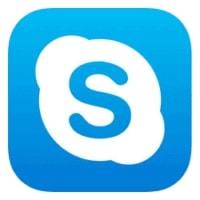
You can buy a local phone number in 26 countries, including the U.S. but amazingly not Canada (that’s okay we have Fongo: booyah!). You can answer calls from anywhere in the world for free with WiFi/data, or you can forward the calls to a local number at your destination (at Skype international calling rates).
The cost for a phone number varies depending on the length of plan you sign up for, but it’s about $5/month. No porting services are currently available. And in my experience, the connection quality with Skype can be unreliable.
Google Voice
To be honest, in researching Google Voice for this article, I found the system convoluted. But as far as I can tell, here’s the scoop.
You can only get a Google Voice number if you are located in the U.S. and have a U.S. phone number to set the account up. (After setup I believe you can terminate the U.S. number). For $20, you can port your existing cell phone number to Google Voice.
While you are in the U.S., you can make (and I assume receive) calls to the U.S. and Canada for free.
While you are traveling, you can use Google Hangouts (a related app) to make (and receive?) calls. Calls to the U.S. and Canada with Hangouts are free; per-minute rates apply to other countries.
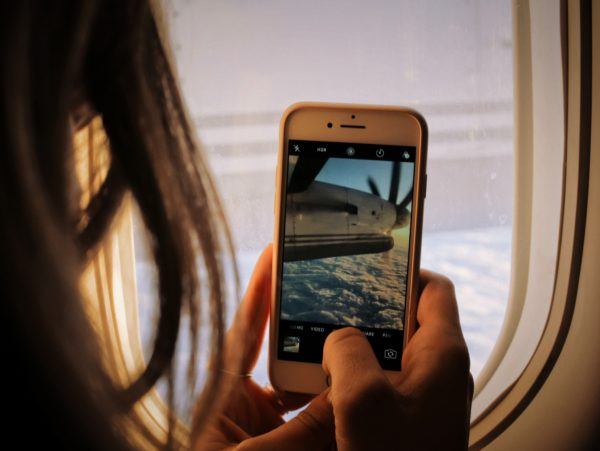
Best Cell Phone Plans for Digital Nomads and Full-Time Travelers
If you’ve read through all these options, you’ve probably already figured out what will work best for you. Here are some recommendations:
Online Phone Number and Data SIM Combo
This is my current strategy, both abroad and at home in Canada. I use Fongo for my Canadian phone number (but depending on where you live you can use Hushed, Skype, or Google Voice), through which I can make and receive calls to/from Canada regardless of where I am in the world.
To ensure a constant connection to make/receive calls and perform any other data-related functions (like using Maps and Uber), I also have a Data SIM card (eSIM).
Using this method, my total telecommunications costs are less than $200 per year, I am constantly connected, and I have an official number in Canada for residence/legal purposes.
While I rarely need a local phone number at my destination (see “other ways to stay in touch” for alternatives), if I do need one, I either buy a local SIM card or use Hushed.
Ditch the Home Number Entirely and Buy Local SIM Cards
This is what I did for most of the first 12 years that I traveled full-time. I had no phone number in my home country for friends and family to reach me on; instead we relied on other ways to stay in touch which were all free (we’ll address these methods shortly).
To have a local number (and optionally, data) abroad, I would buy a local SIM card – preferably at the airport for ease of installation/connectivity and a good price.

Other Ways to Stay in Touch While Traveling (With Both Locals and Family/Friends Back Home)
In many countries I haven’t had SIM cards at all. I’ve either been passing through too quickly to bother, or I’ve had sufficient WiFi (and in recent years a data SIM card as well) to take care of all my communications needs with locals using the methods below.
And through all my travels, I have exclusively used these methods to stay in touch with family and friends back home.
Here are some ways to stay in touch with people around the world without needing a phone number. All of the options below are free to use with WiFi and data.
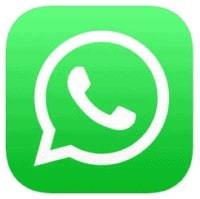
WhatsApp is a cross-platform messaging app that allows you to text, call, and even video call others for free. WhatsApp uses an internet connection so it’s perfect for travelers who don’t want to rack up an international phone bill.
WhatsApp can be used for instant messages, voice calls, and video calls. Both users must have WhatsApp installed.
In many parts of the world, WhatsApp is the standard for daily communication.
In Bali for example, because almost everybody uses WhatsApp, I was able to negotiate a place to rent with some locals there (who didn’t use email; we exchanged free voice calls and messages) while I was still in Japan!
In other countries (like Peru and Ecuador for example), pay-as-you-go phone plan top-ups include unlimited WhatsApp usage. Thus, some locals will put a dollar or two on their phone and exclusively use WhatsApp.
Also, contrary to popular belief, you don’t need an active phone number to use WhatsApp. You only need it to initialize your account and/or to change the phone number on your account. For example, I installed WhatsApp when I lived in Grenada and used my Grenada phone number to set the account up. After leaving Grenada, I continued to use WhatsApp seamlessly around the world. For new contacts to add me, I gave them my (discontinued) Grenada phone number, no problem. Years later, when I got a phone number in Thailand, I changed my WhatsApp contact number to the Thai phone number. I did it again with my Canadian number, just because it’s easier to have others in Canada add me as a WhatsApp contact if I’m not giving them some random foreign phone number.
FaceTime / iMessage
iMessage is for instant messages, and FaceTime is for audio and video calls.
This one is for Apple (iPhone/Mac) users only, but is a very user-friendly and reliable way to stay in touch, with a sleek interface and relatively stable connection.
Facebook Messenger
Almost everybody has Facebook these days, and their messenger app has functionality for making audio and video calls as well as sending instant messages. Connectivity is pretty good.
Skype
A free Skype account allows you to do audio and video calls with other Skype users. You can also load money on your Skype account and use it to call land lines and cell phones anywhere in the world. You can also buy a local phone number in a variety of countries, as mentioned earlier in this article.
Google Hangouts
With a Google account, you can access hangouts and do free audio and video calls with other Hangouts users.
The bottom line is that there are a lot of great options for international phone plans. It really just depends on your needs and preferences. If you need unlimited data, then T-Mobile or Google Fi might be the best option for you. On the other hand, if you’re only looking for a cheap way to stay connected, then an eSIM data plan might be the way to go. Whatever you decide, just make sure to do your research so you can find the best international phone plan for your next trip!
This post took many weeks to research and write (and many years of trial and error to come up with the best options)! And I’m constantly updating it. Did I miss something? Do you have another way to stay in touch that you’d like to share? Please do so in the comments below!

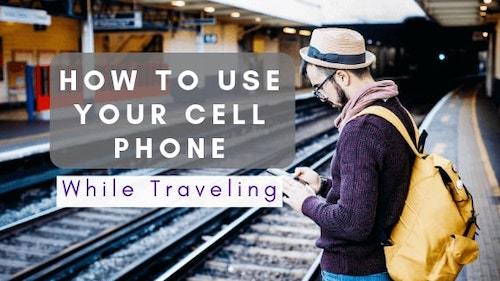


Hi Nora,
thank you for mentioning Keepgo products in your guide. It is really clear and for sure should be helpful for a traveller of any kind.
Thanks, Liliya! I look forward to testing out KeepGo’s Mobile WiFi Hotspot soon, and reviewing it for my readers. 🙂
Whoa 150 smackers Nora. That will wake ya up LOL. Big time charges on roaming I see. We have a phone, grab minutes and pay no more than $40 a month, usually $30 or so. Not big phone folks though. I wish to be looking up at the world not down at the cyber world. Super post, really helpful.
Ryan
Hey Ryan,
Yeah, I’m not a huge phone person either. I prefer to work on my laptop and use my phone for incidental things. At $150/year in total phone expenses, I think I’m doing pretty well!
Very good article Nora. I shared it to a couple international travel facebook sites. I hope that’s ok. Thanks for publishing a practical guide free of the techno mumbo jumbo. Techno babble’s details are important, but often not required for a lay person to make a decision. Thanks and be well!
Thank you John! And I always appreciate shares, so thank you for that as well. 🙂
Hi Nora, thank you for this important resource that I will be bookmarking! I will add that in the U.S. my provider at the time (AT&T) has unlocked my phone *for the duration of my trip* while I was still under contract with them, which was super helpful as that means I was able to put in a new SIM while traveling in China.
Now I have T-Mobile, which of course means I can get free unlimited data and SMS in many countries. I’m on a family plan and with 5 of us splitting costs, I end up paying USD $25/mo. for my day-to-day use in the U.S. (INCLUDING overseas internet & SMS in many countries).
Hi Wilda,
Great news on both fronts! I’m fascinated that AT&T temporarily unlocked your phone for your trip.
And that’s a pretty snazzy plan you have with T-Mobile. Family plans can be very cost-effective that way.
Great information. I will have some ideas now to help while I travel.
Great to hear, Donna!
Very interesting article. I would like to add that, some apps won’t be used at some countries and instead you’ll need to get that country’s equivalent. Some examples are: VK in Russia instead of (or together with Facebook), Viber instead of Whatsapp in the Balkans, Grab instead of Uber in Vietnam, 2GIS instead of GoogleMaps in Central Asia, Yandex Taxi instead of (or together with) Uber in Russia and other former USSR countries, WeChat in China (for everything you need), etc.
Thanks for the intel, Diego! Great suggestions.
So, what I’m wondering is, if I don’t have a data plan with one of the big providers in the US, T-Mobile, ATT, Verizon, etc. what happens to my cell phone number? I’ve had it forever, so I don’t want to lose it.
Hi Penny,
You can port your existing U.S. phone number to Hushed or Google Voice (profiled in this post).
This would allow you to cancel your U.S. plan altogether and just use a Data SIM card, which works anywhere in the world. This is exactly what I do, in my home country and abroad!
Hi Nora,
Kim from Canada. My bank, every so often, sends a text to my phone with a code to input before I’m allowed access to my account.
If I cancelled my Bell Canada account and got a telephone number from Fongo or Hush, would this authentication process work the same way? Can you still receive texts on phone numbers from either Fongo or Hush?
Hi Kimberley,
GREAT question! Here’s the deal: yes, and no.
With Fongo, I have received authentication/verification codes via text. BUT….in some cases they don’t come through. PayPal is an example; I can’t verify my account by text with them. However they also provide an option to receive a phone call with the verification code; I can always receive those!
My suggestion: Before you get rid of your Bell number, try changing your bank phone number on file to Fongo and see if you can either receive authentication texts or phone calls. Once you get that sorted, you can cut Ma Bell free. 😉
As for Hushed, I’m not sure if they have the same challenges regarding verification texts. They have a pretty slick help service (I emailed them with various questions I had while researching for this article, and they were very helpful)!
Thanks Nora…I will give it a try.
Hi Nora, I’m interested in a Flexiroam data SIM plan. I checked out their website and I saw different plans. The one I was looking at offered a SIM and a microchip. What is a microchip? I’m not familiar with that term. Does it work like a SIM card? Thanks for all you do!
Hi Heidi,
A michrochip is actually a wee little sticker that sticks on to your existing SIM card. When you leave your home country, you just change a few settings on your phone and then you’ll have turned off your home cell phone plan and turned on the microchip (also called a SIM sticker) with the Flexiroam data plan!
(Note: even though you still have your home SIM card in the phone, you won’t have access to your phone number. It’s like you’ve switched SIM cards without actually switching).
The microchip is handy because you can use it whenever you leave your country and you don’t have to bother switching out SIM cards.
Hi Nora, Okay, that’s good to know. I appreciate you explaining. Thanks! 🙂
Hi Nora,
Kimberley again. This info may be useful to others going this route. So, my Flexiroam X Sim card arrived and I installed but I couldn’t get it up and running at first……then I realized…..it was my VPN that was stopping the Sim Card from working. As soon as I shut the VPN off…..Flexiroam started working!
I know you are BIG on always using a VPN when traveling. Which VPN do you use that can be enabled while using Flexiroam? Or, do you turn the VPN off when accessing data?
My new Fongo telephone number is working beautiful and I’m receiving texts from my bank to confirm my ID when I log in so that is all working well.
This article is one of the best you have writen. Thanks so much. I’m going to test Flexiroam for a couple of weeks and then…cut Ma Bell loose!
Hi Kimberley,
I’m so glad this system is working out for you!
I’m on a mission to help Canadians change how they use their phones – at home and abroad!
No, I never use a VPN with a cellular data connection; only with insecure WiFi connections.
That’s very interesting. May I ask why you don’t use a VPN with a cellular data connection? Just wondering…..
If you need a poster child for a Canadian switching over to Flexiroam…just let me know :0)
Hi Kimberley,
My understanding is that cellular data connections are already encrypted. The only reason you would use a VPN with a cellular data connection is to hide your activity from your cellular provider.
From an identity theft/nearby hacker point of view, WiFi connections are where you are vulnerable and need a VPN.
Hi Nora,
Thanks so much for this information. Today I purchased 2 GB of global data using their Promo Code and I cancelled my Bell Account….I am now free of Ma Bell. Thanks for all the work you put into this article. I’m thrilled and ready for my next adventure!
You have great articles and content on your site. I really appreciate finding info of particular use to Canadians – like this article. Thanks for sharing your travel research and wisdom!
Thanks, Kris! As a Canadian myself I’d be remiss not to share some of the awesome things I’ve discovered along the way!
This was so helpful! I had no idea I could get my phone unlocked now that it’s paid off and my carrier took care of it with no issues. And I’ll flag this for down the road when I’m traveling more frequently. It includes more information than many other posts I’ve read about long-term travel phone options. Thank you for sharing this!
Thank you so much, Sam!
Indeed, I couldn’t find any comprehensive articles on the topic, so I created one myself!
I would appreciate it very much if you could share this article, since you found it helpful. Thanks!
Couldn’t agree more – I’m planning to travel long term shortly and after worrying about tax residency, one way insurance, COVID issues around visas/entry and backing up passwords and docs, I woke up one morning and thought Oh God – 2FA! How is that going to work when I’m changing SIM cards in each country and no longer have the old number when the online log in is sending the code to it? Aaagghhh. 2FA is a pain when you’re not travelling and change devices etc let alone gallivanting the world! I think the trick is to set it up before you go, test it out as mentioned here then try and swap device – use another phone, a library PC or something and really reassure yourself that it’s covered. Also, I’m planning to have corresponding apps loaded for every important service like bank, gov etc and all the customer service numbers in a few places so at least I have multiple access portals if the worst happens. I was delighted the other day when I realised I could switch off 2FA on FB but then got a stern email from them saying turn it back on or your business ads and line of credit could be compromised. I guess FB is easily hacked as well. Information in here is invaluable and has probably saved many people from getting in a sticky situation
So glad you found this post useful, Trudi! I know you’re “in the weeds” of travel planning at the moment, and it’s amazing how important it is that we have the right setup for phones etc these days – for 2FA among many other reasons!
Do you have LastPass? There is a way to use it for 2FA. I haven’t set it up yet myself (I have LastPass though, and am a huge raving fan lol), but there may be a way to circumvent the requirement to get phone calls / SMS messages for 2FA.
Hey
I have to read up thoroughly on Last Pass and Hushed – on my list. I really underestimated how much time I would need to set things up before going – I was obsessed with paying down, selling off, getting rid. Some good reading yesterday about digital bank cards in banking app – not phone related but you need your phone for it and solves the problem of expiring plastic cards and getting them sent out to you. I don’t think people are being notified that you’ve replied to them in the comments? I just saw that you had by chance as I came back to look at Hushed info again – maybe need to adjust notification settings? Sometimes comments sections are so useful for leads and tips from people’s experience 🙂
Hello Nora,
Just came across your website and am thrilled at the valuable info you share so freely with us.
I am relocating to Mexico from Canada this summer and need to purchase a new cell phone. I love your advice “If you’re in the market for a new phone, do yourself a favour and just buy a factory unlocked phone.” Can you please provide some safe and reliable options for purchasing an unlocked phone in 2021? The google search responses give me a headache and are overwhelming since I have never purchased this type of phone before.
Many thanks!
Hi Iris,
Once you know what phone you want, you can probably buy it direct from the manufacturer (eg: Apple, Samsung).
But basically, as long as you aren’t buying the phone through a telecom provider and signing up for a plan concurrent to buying the phone, it’s pretty safe to assume the phone will be unlocked.
Hi Nora,
Thanks for all the great info!
As a long-term traveler, with $170/month T-mobile plan, I wonder about switching to something cheaper, but have questions. Can you answer these please?
1) A local SIM would be useful, especially for grocery delivery apps, but I have tried a dual-SIM adapter and it didn’t work… do you have one you like?
2) I need more the 25 download and more than 10 upload, how fast is the phone data?
3) Sometimes my AirBnB does not have good cell phone reception, then a hotspot is useless, is it not?
4) I tried buying local data in the mountains of Italy where they do not have fiber yet. I burned through the 100GB of data for 50 euro I bought in 1 week! My T-mobile plan provides unlimited data, so I don’t have to run out and buy more data.
Please excuse me if some of my questions are basic. And thank you ahead of time for your brain time!
Hi Dina,
These are great questions. I’ll do my best to provide great answers. 😉
1) Apologies, I didn’t even know there was such a thing as a dual-SIM adapter, much less which ones are best. Do you need to have two SIMs going at the same time?
An alternative to getting a local SIM could be to use WhatsApp to stay in touch with people in your area. (Though that might not help with grocery delivery. You could just switch out SIM cards for tasks like that).
2) I believe cellular data is only as fast as the signal and connection, so it probably varies by location more so than by provider.
3) Yes…if the hotspot uses a SIM card (and most of them do), it will be dependent on local cell signals. So if the cell signal is inherently bad, the hotspot won’t be any better. I generally only recommend hotspots for multiple people, or solos who need to connect multiple devices. Otherwise, you can just tether your phone to your laptop for data.
4) 100GB of data in one week?!?!?! Holy moly! I didn’t even think that kind of consumption was possible! I use less than 30GB in a YEAR! Though most of the time, I am on WiFi, and when I’m not, I’m generally judicious about my usage.
Nice post thanks a lot for sharing as it comes with a lot of details and it has been very helpful.
Some great content here Nora, but please update/clarify the info for Flexiroam. I was greatly disappointed to find out it’s ONLY esim now. A big con for those of us without the latest, fanciest phones!
Hi Pamela,
Actually, that’s not true! I love Flexiroam, but they are NOT intuitive, so I totally understand why it looks like they only do eSIMs. But they WILL send you a physical SIM card.
Select the package you want (which will say eSIM), then on the checkout page you’ll be given an option to say you do not have an eSIM compatible device, at which point they will give you instructions for how to have a physical SIM card mailed to you.
Thank you Nora! Their web site definitely does not make that clear!
Hi Nora, thanks for your article and your other work and YouTube videos. I’m just starting into more extensive travel and the stuff you are sharing is very helpful.
I was looking into Hushed as I often need to receive calls from US based phones (I’m Canadian also). I looked at Hushed’s reviews on Trustpilot and the recent flurry of 1-star ratings and complaints has me concerned. Thoughts?
Thanks,
Bill
Hi Bill,
I have no personal experience with Hushed, so unfortunately I can’t speak to that. But….you need to receive calls from US-based numbers….do you currently get these calls to a US phone number, or a Canadian one?
Because if having a Canadian number is okay, with Fongo, you can get calls from anywhere in the world (regardless of your physical location, they are paying the rate to call a Canadian number). You get to take the call for free (again regardless of location), as long as you have a Wifi or data connection.
If you need a US number to receive those US-based calls, you could get one through Skype as an alternative to Hushed.
Hi everyone. This has been so helpful…and, for me, slightly confusing. Maybe because I have a weird scenario. What I truly need is JUST data for Google Translate and Google Maps on-the-go. I can use Whatsapp for everything else and WiFi in the home where I will be staying. Would the solution be an international data card? And just use it with my existing (American, Verizon) iPhone & phone number? Or buy a cheapo phone in Italy with data only? Is that even a thing? I’m going for six weeks and I’m not near any borders. PS Nora you are a complete God-send.
Hi Kelly,
Yes – an international data SIM card (eSIM if you have a new enough iPhone) would be ideal! Check out this article for more on that: https://www.theprofessionalhobo.com/finding-the-best-esim-for-international-travel-your-ultimate-guide/
As for your US Verizon number, unless you have a “wifi calling” option, you’ll need to turn off your home SIM card while you’re away, otherwise you’ll get charged for roaming, which can get very expensive.
Hello Nora
Thank you for sharing your travel experiences.
My question is with Fongo. When you call your mom in Toronto does she also have a Fongo account or just a regular landline or cell phone. We have elderly parents that we would like to keep in contact with.
Great question, Jeff! This is the magic of Fongo: you can make/receive calls to/from any phone number – land line or cellular! Your can call and receive calls to/from your parents normal number, regardless of where you are in the world – as long as you have WiFi or data. And…it’s free! I didn’t believe it when I first tested it out, but I’ve been using it solidly since 2017.
Hey Nora, thank you for free sharing of lists. I have a question, can I use these numbers for whatsapp?
Hi John,
Absolutely! When you input a number to WhatsApp, they send that number a text message to confirm and initialize. Then, you’re good to go.
You can also change your phone number on WhatsApp, and maintain your existing chat history and contacts.
You can ALSO never use that phone number again after setting it up, and WhatsApp will continue to work. Once I got a SIM card in Thailand, used it to set up WhatsApp, and then left Thailand and that SIM card long behind for YEARS and continued to use WhatsApp with that number. After setting it up, it is merely something used to identify your account and for people to discover you; it has no bearing on your actual phone plan.